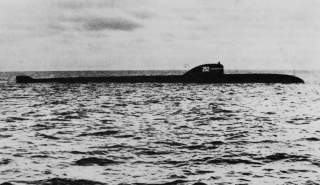The Terrifying Reason Why This Dead Russian Nuclear Submarine Is a Ticking Time Bomb
The next Chernobyl?
While K-27 ultimately turned out to be a disaster, her lead-bismuth technology would eventually be used onboard the Soviet Union’s later Project 705 Lira (Alfa-class) boats. Those vessels—though incredibly fast and deep diving—were eventually withdrawn from Russian service due to the sheer expense of maintaining them. Meanwhile, the United States made one very brief foray into the world of liquid-metal cooled reactors with the USS Seawolf (SSN-575) in the 1950s, but U.S. Navy quickly abandoned the troublesome sodium-cooled powerplant in favor of pressurized water reactors.
Based on the November-class (Project 627 Kit) submarines, the ill-fated K-27 was the first and only Project 645 nuclear attack boat built by the Soviet Union. Like the United States, the Soviet Union often experimented with advanced technologies that were well ahead of their time. Indeed, with its pair of VT-1 liquid-metal cooled nuclear reactors, K-27 was very much a science project first and an operational attack boat second.
Recommended: North Korea has Thousands of Tons of Chemical Weapons
When K-27 was first laid-down on June 15, 1958, she was the first Soviet submarine designed with a pair of novel lead-bismuth cooled reactors. While the new reactors were smaller and more powerful than conventional pressurized water reactors, the innovative new powerplants were troublesome from the beginning. Nonetheless, K-27 quickly accumulated an impressive record in Soviet naval service—including one where she became the first Russian nuclear attack boat to remain submerged for 50 straight days.
Recommended: Why the Korean War May Have Never Really Ended
But despite her impressive service record, K-27’s lifespan was a short one. The submarine’s operational life was cut short due to a reactor accident. On May 24, 1968, K-27 suffered from a failure in one of her VT-1 reactors—power suddenly dropped from 87 percent output to seven percent. The power drop came with a massive increase in gamma radiation that flooded the reactor compartment.
Recommended: The Real Reason China Has Built a Massive Military
Additionally, gas vented from the reactor and spread to the other compartments. “We had a radiation detector in the compartment, but it was switched off. To be honest, we hadn't paid much attention to the radiation dosimeters we were given. But then, our radiation supervisor switched on the detector in the compartment and it went off the scale. He looked surprised and worried,” recounted Vyacheslav Mazurenko, then a 22-year-old chief warrant officer (CWO), to the BBC.
The crew did not fully understand the extent of the problem with the reactor until it was far too late. But two hours after the initial alarm, crewmen had to be physically carried out of the reactor compartment due to radiation sickness. Eventually, the crew managed to surface the stricken submarine. The journey back to Gremikha (Ostrovnoy) on Russia’s Kola Peninsula took more than five hours.
“When the sub surfaced to make the trip back to the docks, the division ordered it to cut its engines and await special instructions,” Mazurenko recounted. “The captain [Pavel Leonov], however, decided to keep going, because if the sub stopped for several hours nobody would survive long enough to get it back to base."
All 144 members of the crew had been exposed to radiation—with nine eventually dying of from radiation poisoning. K-27 was permanently laid-up soon after in June 1968, though the Soviets carried out various experiments onboard the vessel until 1973. K-27 was eventually decommissioned February 1979 and then scuttled in very shallow water—just 99ft deep—in the Kara Sea on Sept. 6, 1982, where she remains as a ticking environmental time bomb. Indeed, the problem is so grave that many environmental scientists believe that the submarine must be retrieved and disposed of properly.
“Radiation leakages will come sooner or later if we just leave the K-27 there. The sub has already been on the seafloor for 30 years, and it was rusty even before it was sunken. Leakages of radioactivity under water are nearly impossible to clean up,” editor of the Independent Barents Observer, Thomas Nilsen, formerly of the Bellona Foundation and co-author of The Russian Northern Fleet: Sources of Radioactive Contamination told RT in 2012. “Our challenge today is to find a way to lift it without shaking the reactors so much that an uncontrolled chain-reaction doesn't start. If that happens, a large amount of radioactivity can leak out to the fragile Arctic marine environment.”
While K-27 ultimately turned out to be a disaster, her lead-bismuth technology would eventually be used onboard the Soviet Union’s later Project 705 Lira (Alfa-class) boats. Those vessels—though incredibly fast and deep diving—were eventually withdrawn from Russian service due to the sheer expense of maintaining them. Meanwhile, the United States made one very brief foray into the world of liquid-metal cooled reactors with the USS Seawolf (SSN-575) in the 1950s, but U.S. Navy quickly abandoned the troublesome sodium-cooled powerplant in favor of pressurized water reactors.
Dave Majumdar is the defense editor for the National Interest. You can follow him on Twitter: @davemajumdar.
This first appeared last year.

